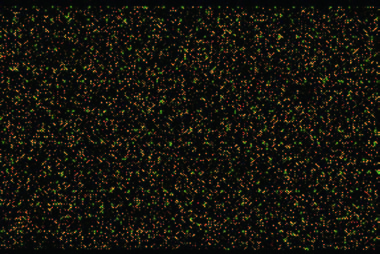This is an archive of information released in the past.
Disclaimer: It may contain broken links or outdated information. Some parts may not function in current web browsers.
*Visit https://humans-in-space.jaxa.jp/en/ for the latest information.

Experiment
- News
- Kibo Utilization Strategy
- Kibo Utilization Plan
- List of JAXA's Utilization Themes
- Experiment Facilities
- Space Environment Utilization
- Archive
Do frog cells form “domes” in space, too?
Control of cell differentiation and morphogenesis of amphibian culture cells
Dome Gene
Background
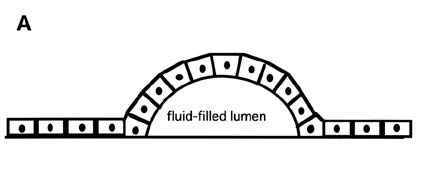
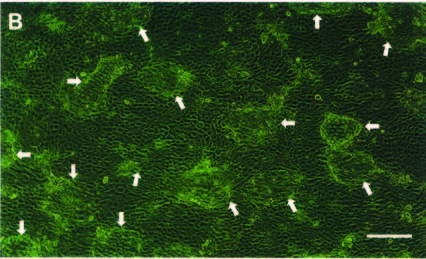
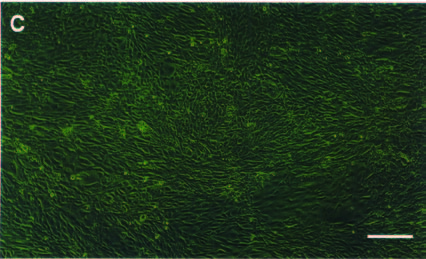
Figure 1. Dome formation
A: When separate cells are put together, they begin to communicate with each other and play their own roles to shape certain forms.
Xenopus laevis kidney-derived cells (A6 cells) form dome-shaped structures.
B: Micrograph of A6 cells
Arrows indicate dome formation.
C: Micrograph of A6 cells cultured under a simulated microgravity condition
Dome formation is inhibited.
The Xenopus laevis is an amphibian which lives in water as a tadpole until it starts to live on land. Gravity in water, where buoyancy is provided, is significantly different from that on land. The difference should affect organs of the frog’s body. This experiment will focus on the kidney of Xenopus laevis.
When cells from the kidney (kidney-derived cells) of Xenopus laevis are cultured, they form particular shapes. They are raised like domes and called “dome structures” (Figures 1A and 1B). No cells from other organs form such structures when cultured.
Initially, the cells are separated, sharing their characteristics. As they proliferate, they come in contact with each other, forming clusters. They begin to function differently from when they are separated. They play their own roles in the clusters and form dome-shaped structures. It looks as if they communicated with each other (Figure 1A).
During the development of an organism, as a fertilized egg gradually divides, what initially are aggregated undifferentiated cells with unknown identity gradually become systematically differentiated into organs with various functions. In the process of culturing kidney-derived cells, no fertilized eggs divide, but there may be phenomena related to cell differentiation and development because cells in clusters play their own roles and form structures in the process of morphogenesis.
The dome structure is similar in structure to the Bowman’s capsule, a structure in the kidney of animals that acts as a filter to remove waste products from the blood. Cells may form a very primitive version of the structure that is the most important in the kidney.
Objective
In the 1G environment on Earth, kidney-derived cells begin to form domes in about 10 days. What will happen in space, where gravity is very low? Will domes be formed as on Earth?
An experiment with simulated microgravity on Earth found that the time for dome formation was different. It was discovered that the genes that act on dome formation on Earth acted differently under the simulated microgravity condition (Figure 1C).
In this experiment, kidney-derived cells will be brought to space to see whether, when, and in what shape they will form domes and to study the genes involved in dome formation. Cells from the liver (liver-derived cells) of Xenopus laevis will also be brought to space for evaluation. Unlike kidney-derived cells, liver-derived cells do not form domes; they will be brought to space for comparison.
Outline of the Experiment
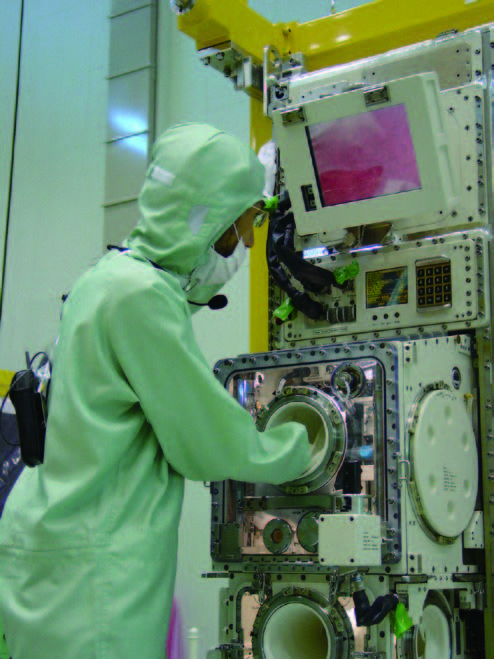
Figure 2. Clean bench in Kibo
Cultured cells can be observed through the built-in microscope. Microscope images are showed on the display at the top of the device.
Cells from the kidney and liver of Xenopus laevis in culture will be launched. They will be cultured at 22クA訝 under microgravity or about 1G artificial gravity.
The kidney-derived cells will be observed for the time of dome formation and the dome shape. Comparisons will be made between the microgravity condition and the artificial gravity condition. Once domes are formed, astronauts will observe them under a microscope.
A device called a clean bench will be used for observation (Figure 2). It has a built-in microscope, which allows immediate observation of samples such as cultured cells. Astronauts observe cells on the LCD display placed at the top of the device. Images can be sent to Earth and researchers can see them.
The cells before and after dome formation will be treated with a chemical and frozen for preservation. They will be recovered on Earth. The entire experiment will last for about 10 days.
After recovered on Earth, the cells will be evaluated for differences in the genes involved in dome formation, using the world’s highest quality DNA microarray.
This is the Point!
Makoto Asashima has long been specializing in developmental biology. He has discovered that a protein called activin plays a very important role in determining which cells become which organs in the process where fertilized eggs divide repeatedly to gradually form various body parts and organs. He has identified the action of activin.
In this space experiment, the expression level of the gene for activin production may change. Yet unknown genes may be expressed and alter dome formation.
Asashima has conducted many embryological experiments using frog and newt eggs. During early development, humans and frogs are similar in the orders of organ formation and gene expression. This experiment will provide important clues to the understanding of whether normal development, differentiation and morphogenesis will take place in space and how they may be affected by weightlessness. Ultimately, the findings may pave the way for the days when people will live in space and alternation of generations will take place there.
How are genes evaluated?
The expression “analyzed at a genetic level” is used in almost all space experiments these days. How are genes evaluated exactly?
Since genetic DNA is a blueprint, it does not increase or decrease. Usually, in protein production, a messenger RNA (mRNA) reads information contained in DNA and produces a kind of template. It is then carried to a ribosome, or a protein factory, where amino acids are brought in according to the template and assembled to synthesize protein.
Therefore, when someone says that genes have increased or decreased, it generally means that the quantities of the materials involved in the process at and later than the RNA phase have changed. When a gene starts to provide mRNAs, it means that the gene has become activated. This is a phenomenon called “gene expression.” Measuring gene expression means measuring the level of mRNAs.
To measure gene expression, a technique called DNA microarray is used. Thousands to tens of thousands of genes to be evaluated are arranged over a chip. Genes extracted from cells recovered on Earth after a space experiment are placed over the chip. The genes that have been expressed in space develop a color and glow. The quantities of the genes can also be measured. This technique reveals which genes have been expressed in space and which have not.
 |
Principal Investigator Makoto Asashima Vice president and board member, University of Tokyo |
| Copyright 2007 Japan Aerospace Exploration Agency | Site Policy |
